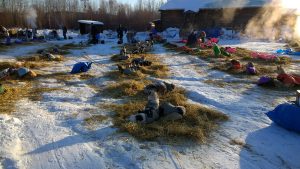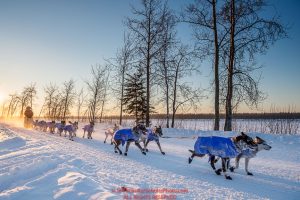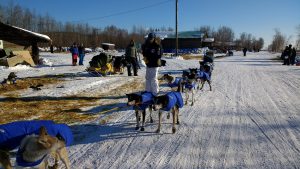March 8 Tanana 9:50AM Middle of the Pack
While our lead competitors—-Wade Marrs and Dallas Seavey—-are halfway to Ruby, the middle of the pack settles into a trail rhythm. These competitors have a different view of the trail and priority.

the middle pack settles into a expedition rhythm
At the round table in the checkpoint community hall, while changing socks, a competitor says he will take two rest stops on the way to Ruby. “My dogs just are not ready for the big 60 mile runs. I’ll do three 40 mile runs.”
Dee Jonrowe, who has run decades of Iditarods, is in the race this year for the challenge. When not inflated by billowy down gear and walking about now in her layered clothing in the checkpoint, one realizes that she is a slight woman. Diminutive is a huge advantage in the musher world, but how can she handle that powerful team of sixteen dogs? She says that her sled, a limber rendition designed to absorb the bumps on irregular trail, is a workout to handle. She is admittedly tired and thinks about taking a 24 hour break.
While I nurse a cup of coffee, the french videographers following Nicolas Vanier document activity within the community center. Mushers are hanging clothes on a suspended lattice work of spruce poles above a monstrous wood stove. Now appears Nicolas and stands before the cameras describing his adventure. All of a sudden I start using words like “rendezvous” after hearing mellifluous french in the checkpoint. One of the camera guys describes their mission. Part of an independent film company, they are actually preparing the documentary for French TV. One camera is at the front of the race to catch the competitive action while the other focuses on Nicolas. REally a congenial crew to be around—hope to see them in Huslia, the birthplace of the modern sled dog.
Volunteers in the Iditard checkpoint team have been working like dervishes all night. One, Linda Peterson of Washington, stops to dry out and take a break. She saw the race as a spectator and determined to become directly involved. She is now in the middle of the action here in Tanana. I cant say enough of the volunteers, who keep the checkpoint well ordered, and organize the chaos of incoming and outgoing teams.
Zoya DeNure has had obstacles the last several Iditarods and is determined to take her team all the way to the finish. She retrieves clothes items from the spruce pole rack above the wood stove and reports that “She is very happy with her team.” Later, outside I note she is preparing to depart, packing her sled. She is part of a new scene in the dog yard contrasting with the fast moving pace of the front runners, now replaced with a more deliberate determination.
Dog cookers, the heat waves from fast burning alcohol shimmering in the sun, are steaming with hot water and thawing rations of meat and fat. The alcohol is a clean burner and does not compromise the taste of the ration. The dog yard is unruly. The front pack is accustomed to the race format and dogs rarely bark unless a neighbor gets ready to depart. They know the drill and stay calm on their straw beds. The middle pack teams are generally on a grand adventure and bark and howl needlessly in the morning light. Mushers are methodically fitting booties on their chargers, in contrast to the front pack who are in constant competition with themselves to be faster.
By happenstance I introduce myself to a guy with a clear southern accent. It is Seth Barnes from the gulf coast of Alabama. A pair of dogs exchange growls, some argument about a morsel in the straw and Seth interrupts our conversation “Y’all can play, but not fight.” That seems to be enough to settle the discussion. He has worked for Mitch Seavey and speaks authoratatively about the teams. “Oh yeah, it’s a better team than Dallas.” One logs comments like that in the back of the mind—more a little later.
We talk about the front pack and then get back to his race. He is clearly an experienced musher and tells me he is taking his time and hoping to generate some real speed in the second half of the race. This guy is competent and I hope to catch up with him later and watch his progress.
Moving about again, Mark Selland, a doc from Anchorage, Alaska is looking over his dog team. The team looks great with that luxurious well hydrated appearance. Asking about his race, Mark looks at his team and observes that his runs are taking longer than planned. I am thinking he must be a perfectionist because all looks , to me, under control for a great run. check out the wonderul photo by Jeff Schultz

Mark Selland runs down the road and into Tanana during the 2017 Iditarod on Wednesday morning March 8, 2017.
Photo by Jeff Schultz/SchultzPhoto.com (C) 2017 ALL RIGHTS RESERVED
Fortuitously, and without really any effort to editorialize, I hear this guy with a Norwegian accent. It is the very accomplished musher Geir Huelvik from Norway. Geir comes with very serious credentials from the Norwegian mushing community and accustomed to competition. AFter several times repeating his name, he steps in, “I have been working with Dallas (SEavey) for several years and he still cannot pronounce my first name,” the intimation being that the next several years will be dedicated to prounouncing his last name “Huelvik.”
Geir is running a younger team for Dallas SEavey. In an effort to confirm the dialogue with Seth, the trainer with Mitch SEavey, I ask a pointed question. “Do you think Mitch’s team is better than Dallas?” Oh , well, big surprise, we get a contrary opinion. Geir has been running dogs for more than twenty years, “Well, I don’t know. Dallas says it’s a better team than last year.” He shrugs his shoulders with typical Norwegian understatement, “I think they’re good,” which means he thinks the team is really good. Geirs team is relaxed on the straw in the morning sun. It’s all going well he reports for his team in training.
If it can’t get any better, Allen Moore, the Yukon Quest Champion, appears at his team. He is running the second team from he and Aliy Zirkles kennel and offers wonderful insight into the mechanics of the race at the front. His partner Aliz Zirkle is of course prime time front runner and a huge fan favorite. He reports that her team has a little intestinal bug and she is working to stay in the front of the pack while allowing her team a lot of rest to recover. “I had the same problem in the Yukon Quest and I think the dogs will bounce back in a couple of days.”
Allen ran the Yukon Quest in February. I know he is very analytical and ask him about the calculus of alternately hauling dogs as does Dallas SEavey. He offers that he and Aliy consider the strategy, but it requires discipline and physical effort by the musher. Allen thoughtfully offers that haulig and resting dogs seems to work very well on good trails and maybe not so well on soft trails where the effort may not equal the advantage.
Aliy is consistently to the front, but Allen remarks that her team loses steam in the final push to the finish relative to Dallas SEavey. This is a part of the race that they have worked on in training. OK, so stay alert Aliy fans. She is anonymous at the moment, still to the front, but coasting for a while untill her dogs recover a case of the trail crud.
Final thoughts
The background of heartfelt howls continues uninterrupted in the background. Middle of the pack is ready to move again in the warming sun.

Ryan Anderson, Bear Grease champ from Minnesota, departs Tanana at noon

































